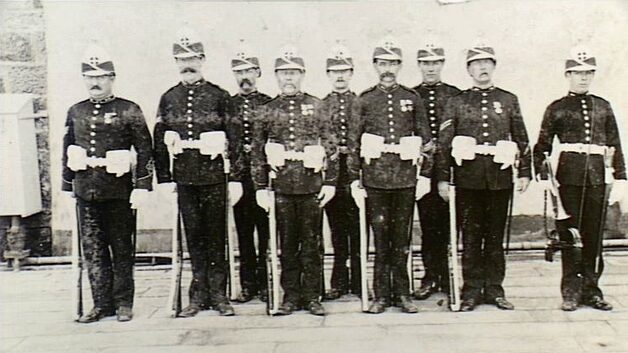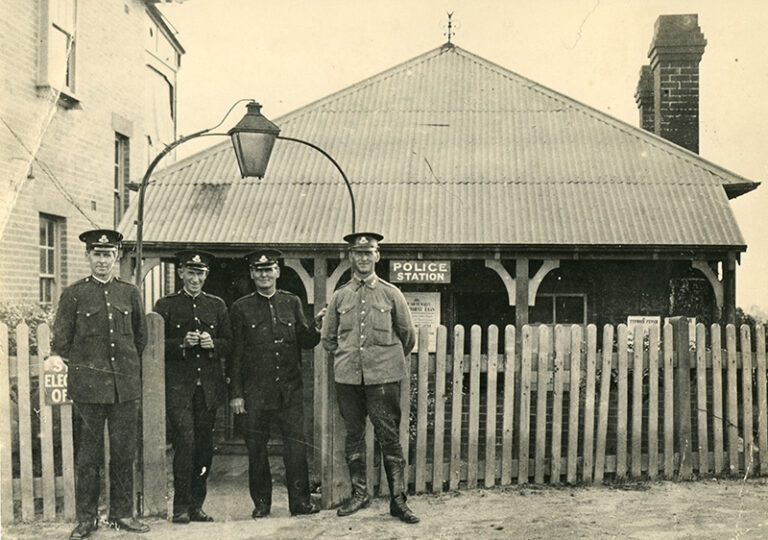An Old Headstone
The Devonshire Street Cemetery, established along an ancient sandhill on the outskirts of old Sydney, became a forgotten relic as the city expanded around it. By 1901, it had become a decrepit anachronism from the colonial past, surrounded by the urban sprawl. That year, the government announced a bold plan to exhume the cemetery’s 38,500 burials and reinter the remains in various cemeteries across the state. The land was to be cleared for the construction of Central Railway Station, marking the end of an era.

Amateur historians Arthur and Ethal Foster took it upon themselves to document this vanishing history. Photographing and cataloguing as many significant monuments as possible before the work began, they came across an intriguing headstone in the Church of England section of the cemetery, which dated back to 1819. It was the grave of Samuel and Esther Bradley, two of the earliest burials in the cemetery. The inscription on their headstone revealed a chilling tale:
SACRED
to the MEMORY of
SAMUEL and EASTER BRADLEY
who where Inhumanely Murder’d
by their own Servant
on the 15th of August 1822.
S.B Aged 59 Years
E.B Aged 65 Years
The Bradleys lay undisturbed for seventy-nine years, their story buried under weeds and time. The unusual inscription stood out, a reminder of a brutal past. But what happened to Samuel and Esther on that fateful day in August 1822?
A Disturbing Discovery at Birch Grove
The story began on August 15, 1822, when prominent free settler Alexander Berry was travelling by boat from Sydney to visit his business partner, Edward Wollstonecraft, at his estate on the North Shore (now the suburb of Wollstonecraft). Along the way, Berry decided to make an impromptu visit to his friend Samuel Bradley, who had moved to Birch Grove Estate on Longnose Point only three weeks earlier. Berry’s party disembarked at Snail Bay and walked the short distance to Birch Grove House, a stately sandstone home.

Upon arrival, they found the house eerily silent. Berry later described the scene as having “the unwelcome aspect of desertion,” with doors wide open and signs of a recent plundering. Half-open trunks and scattered clothing lay about, creating an unsettling atmosphere. After twenty minutes of exploration, the group found a limb bone in an advanced state of “purification.” Mistaking it for an animal bone, they left the property and continued their journey to Wollstonecraft’s villa.
However, the incident weighed heavily on Edward Wollstonecraft. Concerned by the description of the house, he dispatched two servants to investigate and take charge of Birch Grove House. The servants’ worst fears were confirmed when they discovered that the bone was, in fact, a decaying human arm. News of the discovery was quickly relayed to the Sydney authorities, and Chief Constable Dunn arrived on the morning of September 2, 1822, to lead the investigation.
The Search for Samuel and Esther
Dunn’s team scoured the property, following the foul stench that led them about five hundred yards from the house. There, they found a freshly felled tree lying across two sandstone rocks. As they moved the branches, they uncovered the mutilated remains of Samuel Bradley, wedged into a crevice between the rocks. His clothing was scorched, and the corpse had been partially consumed by dogs, explaining how his severed arm ended up so far away.
Despite an extensive search involving police and local residents, there was no sign of Esther Bradley. As word of the macabre discovery spread, it shocked the fledgling colony. Soon, people began coming forward with information they thought might help catch the perpetrator responsible for the gruesome crime.

The Last Sighting of Esther Bradley
The last known person to see Esther Bradley alive was Margaret Hodges, who had accompanied her from town on August 15. The two women traveled together on a boat, disembarking at Birchgrove, where they were met by Esther’s servant, a convict named Thomas Barry. Margaret noticed Esther seemed anxious when she asked Thomas where her husband was. Thomas replied that Samuel was in Sydney, which appeared to distress Esther. Margaret bid farewell, waving to Esther for the last time as she sailed away.
The Investigation Tightens: Thomas Barry’s Arrest
Thomas Barry was not difficult for the authorities to locate. He was already serving time on a chain gang along South Head Road after being arrested for drunk and disorderly behavior in Sydney shortly after the Bradleys were last seen. During his arrest, Barry had been searched, and several items belonging to the Bradleys were found in his possession, including two keys, a silver thimble, and a large needle. Barry claimed that the keys belonged to a chest of drawers given to him by Samuel as partial payment for his services and that he had found the other items at the racetrack. The arresting officer noted deep scratches on Barry’s face.
Barry was now the prime suspect in the murder of Samuel Bradley. Although he initially maintained his innocence, insisting that the Bradleys were alive and well when he last saw them, the growing evidence told a different story.

Unraveling the Mystery: Witnesses Come Forward
As the investigation unfolded, more pieces of the puzzle began to emerge. John Cochrane came forward, claiming that he had accompanied Barry on a boat trip to Birchgrove on August 24. The purpose, according to Cochrane, was to collect various household items and nearly a dozen pigs. Cochrane believed the items had been legally acquired and offered to return them to the authorities. The police soon determined that the items belonged to the Bradleys.
That same day, a watchmaker reported that Barry had brought a watch to him for cleaning. The watch was identified as belonging to Samuel Bradley, adding to the mounting evidence against Barry.
A Shocking Confession
Facing overwhelming evidence, Barry changed his story. He now admitted that he had been present at the time of the murders but claimed he was merely a witness and not involved in the killings. He accused two other men, William Barry and Dennis Lamb, of being the actual murderers. The inquest into Samuel Bradley’s death, held on September 5, heard Barry’s allegations. He described a gruesome scene where Lamb shot Samuel in the back and then bludgeoned him with the pistol’s butt. He accused William of attacking Esther, who was later buried in the garden.
The following day, a boat carrying Coroner George Milner Slade, the prisoner Barry, police officers, and the jurors returned to Birchgrove. Barry led the party to a spot thirty yards from the cottage, where they found a shallow grave containing Esther’s body, wrapped in a carpet. Her skull had been fractured, and a deep laceration, likely caused by an axe, ran across her face. An axe, believed to be the murder weapon, was later found hidden in the chimney, with markings matching those found on the felled tree.
The Trial: A Search for Justice
The trial began on October 11, 1822. Thomas Barry, Dennis Lamb, and William Barry were indicted for murder, while John Cochrane and Bridget Howell faced charges as accessories after the fact for possessing stolen property. Witnesses presented a stream of evidence, including articles belonging to the Bradleys and the murder weapons.
Although the evidence against Thomas Barry was compelling, the case against Lamb and William was circumstantial. The jury returned a verdict of guilty for Barry, but the other suspects were acquitted due to insufficient evidence. Barry was sentenced to death by hanging, with the additional punishment of his body being dissected after execution.
The Final Execution and the Grim Epilogue
On October 14, 1822, Thomas Barry stood on the gallows. He declared himself the sole murderer and denied having any accomplices in the crime. Moments later, the hangman sent him to his fate. Barry’s body was delivered to the surgeons at the Rum Hospital for dissection, a punishment rarely seen in the UK by the 1820s but still enforced in the fledgling colony where surgical cadavers were in short supply.
Samuel and Esther Bradley were later reinterred after their remains were exhumed from the Devonshire Street Cemetery in 1901. Though likely reburied in La Perouse, no exact records exist, and their headstone is now lost to time, remembered only in the photographs taken by the Fosters, which remain in the City of Sydney’s archives.
Birch Grove House: From Stately Home to Memory
The scene of the infamous murders, Birch Grove House, was constructed by John Birch in 1810. For over a century, it remained the sole building on Longnose Point until the neighborhood began to develop in the mid-19th century. In 1967, despite its historic significance as the second-oldest home in Australia, Birch Grove House was demolished, replaced by a block of orange brick apartments that still stand today.








